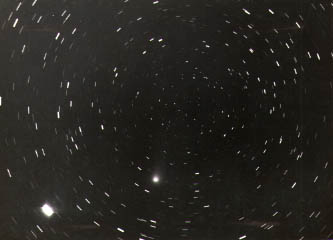
| • LINEAR (1998 M5) is approaching Polaris. At 21:00 on March 15, it
will be within 10' (one-third of the moon's diameter) of Polaris. However,
it is only 9th magnitude and an aperture of larger than 10cm is required.
This reminded me of Comet Panther, which appeared in 1981. At spring of
1981, the year when this comet appeared, Gesie Observatory was completed.
The 60cm reflector captured this comet and Polaris together for the first
time, which were turning around the north pole together. For your information orbital elements of LINEAR and Panther are compared below: |
| Comet Panther | LINEAR | Remarks | |
| T (perihelion) | Jan. 27, 1981 | Jan. 24, 1999 | UT |
| q (perihelion distance) | 1.6573 | 1.7422 | A.U. |
| e (eccentricity) | 0.99897 | 0.99602 | |
| ω (argument of perihelion) | 105.601 | 101.287 | degree |
| Ω (longitude of ascending node) | 331.998 | 333.377 | 2000.0 |
| I (inclination) | 82.648 | 82.228 | |
| P (period) | 64,900 | 9,140 | years |
| The elements for both comets are very similar, although the orbital periods
are very different, approximately 60,000 years and 10,000 years respectively.
Calculations of long periods like these will be greatly affected by measurements
obtained by observation. These two comets might have originated in one
common comet, which broke up into two, or they might have come from the
same region. Whichever the case, it is very interesting that the two comets
with periods of tens of thousands of years passed Polaris closely only
19 years apart. - For us humans 20 years is a long period of time, but for comets it is just an instant. - This photo shows Comet Panther in 1980. LINEAR will pass by Polaris very soon. Weather permitting, photos of LINEAR will be taken and shown next time. |

Polaris and Comet Panther (1980U)
0:15-0:25, 10-minute exposure On March 11, 1981
60cm reflector at Geisei Observatory without tracking
The star in lower left is Polaris.
Copyright (C) 1999 Tsutomu Seki.